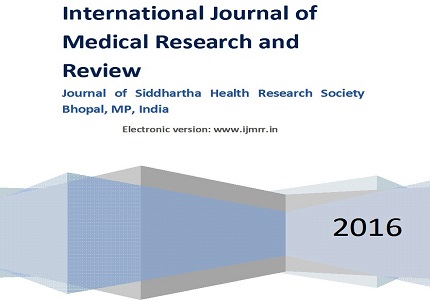A study of electrocardiographic changes in thyroid disorders
Abstract
Introduction: Thyroid plays an important role in the orchestration of various metabolic functions in the body and thus thyroid dysfunction can produce dramatic cardiovascular effects, often mimicking primary cardiac disease.
Aims: The aim was to study the spectrum of electrocardiographic (ECG) changes in hypothyroidism and hyperthyroidism.
Materials and Methods: The present study included 26 cases of hypothyroidism and 24 cases of hyperthyroidism conducted in Department of Medicine, Chirayu Medical College and Hospital, Bhopal. 20 age- and sex-matched euthyroid controls were also included in the study for comparison. Serum free T3, T4, and thyroid-stimulating hormone were done using sensitive chemiluminescence technology. Twelve lead ECG was done in each patient.
Results: The predominant abnormality found on ECG study of hypothyroid cases was sinus bradycardia that was found in16 (61.5%) cases (P < 0.05). ST-T changes in the form of T-wave inversion or ST segment depression and flattening was present in 7 cases (26.9%). Sinus tachycardia was the commonest abnormality in hyperthyroidism seen in 19 (79.2%) cases. Atrial fibrillation was seen in three (12.5%) cases and ST-T changes in 2 (8.3%) cases.
Conclusion: Sinus bradycardia is the commonest ECG change in hypothyroidism and sinus tachycardia was the predominant ECG change in hyperthyroidism. Therefore, electrocardiography is a sensitive tool to detect cardiac manifestations in thyroid disorders.
Downloads
References
2.Disorders of thyroid gland J.Larry Jameson Anthony P. Weetman, 18th edition Harrison’sinternal medicine-2011.341:2911-2939.
3.Hollowell JG, Staehling NW, Flanders WD, Hannon WH, Gunter EW, Spencer CA, et al.Serum TSH, T (4),and thyroid antibodies in the United States population
(1988 to 1994):National Health and Nutrition Examination Survey (NHANES III) J ClinEndocrinolMetab.2002;87:489–99.
4. Hoogendoorn EH, Hermus AR, de Vegt F, Ross HA, Verbeek AL, Kiemeney LA, Swinkels DW, Sweep FC, den Heijer M. Thyroid function and prevalence of antithyroperoxidase
antibodies in a population with borderline sufficient iodine intake: influences of age and sex. Clin Chem. 2006 Jan;52(1):104-11. Epub 2005 Oct 27.
5. Bemben DA, Hamm RM, Morgan L, Winn P, Davis A, Barton E. Thyroid disease in the elderly. Part 2. Predictability of subclinical hypothyroidism. J Fam Pract. 1994 Jun;38(6):583-8.
6. Fahr G. Myxedema Heart. JAMA 1925;84:345.
7. DOUGLAS AH, SAMUEL P. Analysis of electrocardiographic patterns in hypothyroid heart disease. N Y State J Med. 1960 Jul 15;60:2227-35.
8. Trivalle C, Doucet J, Chassagne P, Landrin I, Kadri N, Menard JF, Bercoff E. Differences in the signs and symptoms of hyperthyroidism in older and younger patients. J Am Geriatr Soc. 1996 Jan;44(1):50-3.
9. Northcote RJ, MacFarlane P, Kesson CM, Ballantyne D. Continuous 24-hour electrocardiography in thyrotoxicosis before and after treatment. Am Heart J. 1986 Aug;112(2):339-44.
10. SANDLER G. The effect of thyrotoxicosis on the electrocardiogram. Br Heart J. 1959 Jan;21(1):111-6.
11. Goel BG, Hanson CS, Han J. A-V conduction in hyper- and hypothyroid dogs. Am Heart J. 1972 Apr;83(4):504-11.
12. Gordon G, Soley Mayo H. Electrocardiographic features associated with hyperthyroidism. Arc Int Med 1994;148-153.



 OAI - Open Archives Initiative
OAI - Open Archives Initiative


